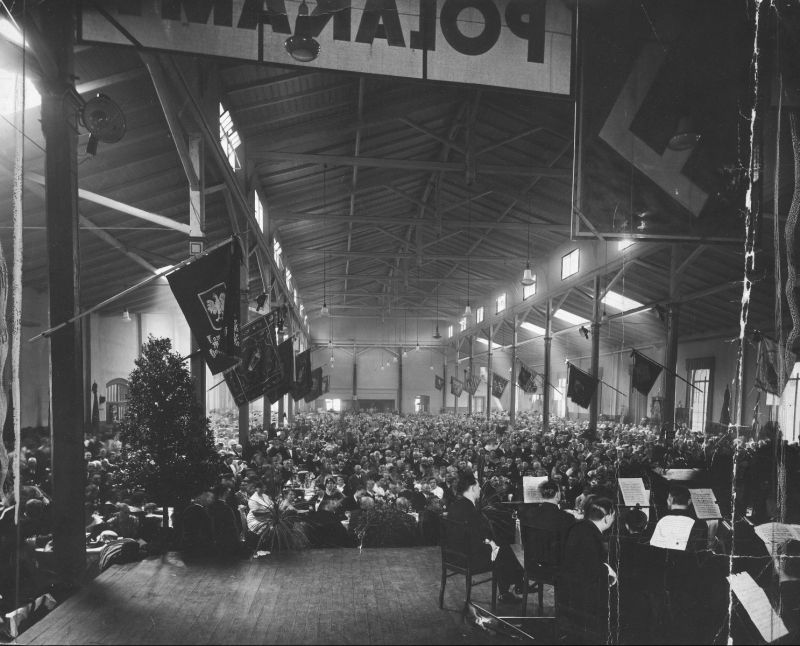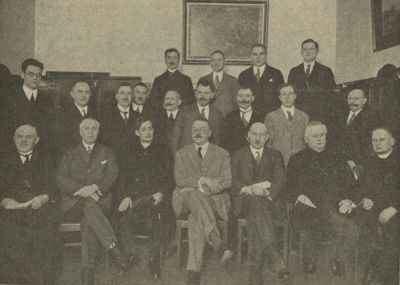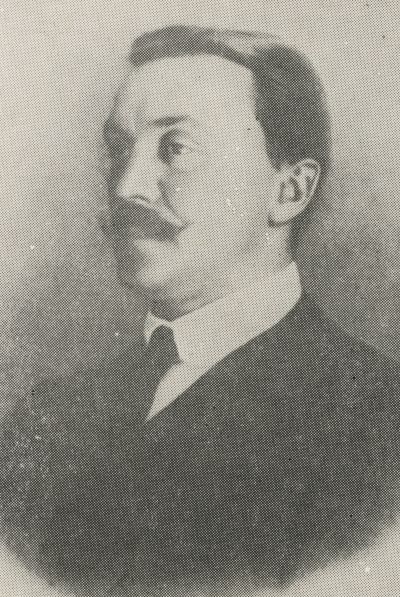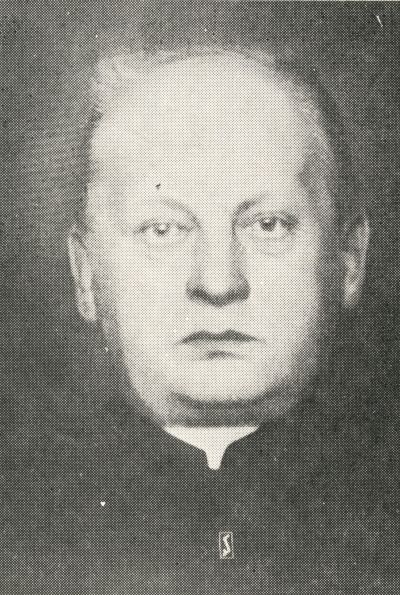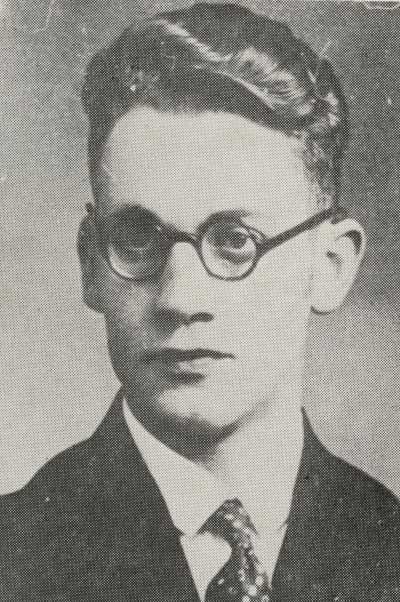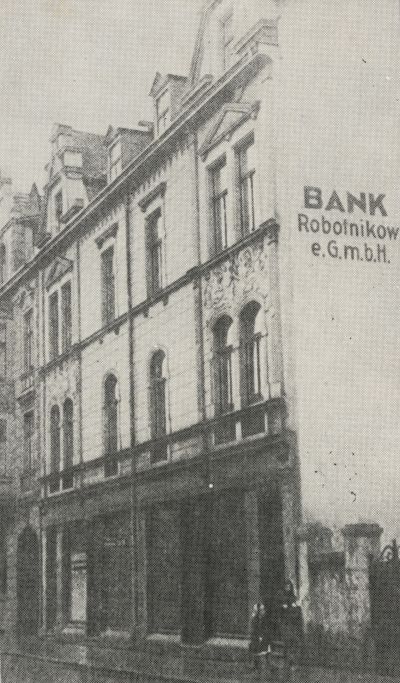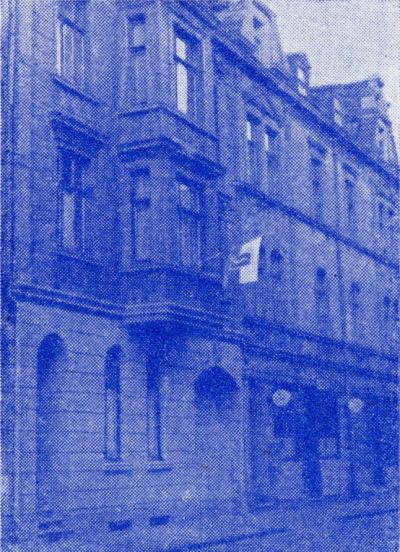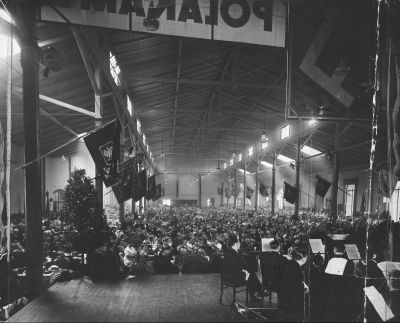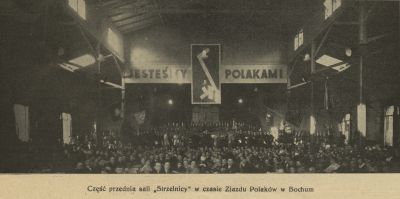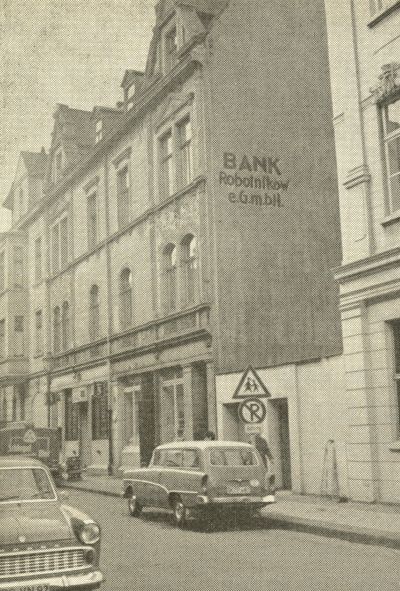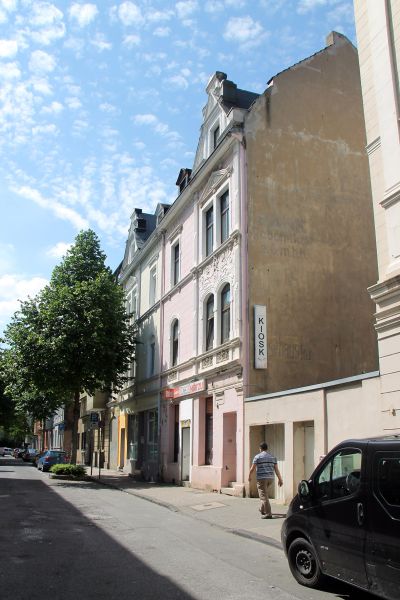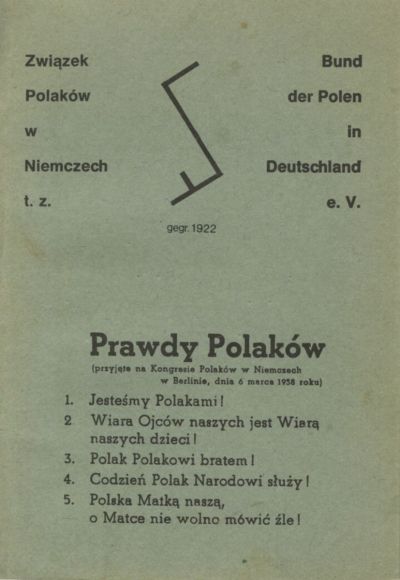The Union of Poles in Germany
Mediathek Sorted

Whilst the organisation was able to flourish in the first few years after its founding, once the National Socialists seized power in 1933, its activities were restricted. Although the non-aggression pact signed by Warsaw and Berlin in 1934 temporarily reduced their involvement in the organisation’s activities, the ‘détente’ phase did not last very long. The outbreak of the Second World War saw the organisation liquidised, its property seized, and hundreds of activists and leaders arrested and imprisoned in concentration camps. Other Poles were conscripted to the Wehrmacht and fought on the front lines against soldiers that had the same national background. Without doubt, in the years that followed, the members of the Union shared the same fate as millions of countrymen - Polish citizens who were subjected to severe repression after part of the Polish territory was annexed by the Third Reich. Deportations, murder and “Germanisation” were the order of the day. Although the organisation was quickly revived in all occupied zones after the Second World War, the Poles that remained in Germany no longer had the strength that would be able to play an important role. Some decided to emigrate to Poland which, as a result of the border changes, included areas that had previously been inhabited by a large number of members of the Union. However, this did not mean that the “Motherland” treated them as they had expected and had dreamt of. The creation of the two German states made the situation even more complicated, both in terms of German-Polish relations and in terms of the Poles’ position in their area. The actions taken by the Communists in Poland at the start of the 1950s led to the organisation in West Germany being split, whilst in the second German state, the GDR, it was disbanded altogether. Over the decades that followed, the Union, which went by the name Rodło, organised events that were typical for this type of organisation, from anniversaries to Polish language teaching, right through to balls and celebrations. In spite of attempts to increase the number of members, an ageing population and emigration meant that Rodło remained a small organisation. Even after German reunification, its activities have not changed. One of its main roles remains its efforts to have Poles in Germany recognised as a minority.
Without doubt, the situation of Poles in Germany after the First World War was fundamentally influenced by the creation of the Polish State. After not having had their own State for over one hundred years, they were now able to count on its support in an organisational, financial and political sense. The Poles were also able to benefit from the support of the Polish diplomatic representatives in Germany. This was all the more important because there was a significant German minority in the resurrected Poland which enjoyed considerable support from the German State.
The Poles in Germany quickly began to organise themselves. Of course, the Polish-German conflict around the western Polish border was a significant factor for the situation at the time The call for a single organisation to be created, which could amalgamate all the smaller associations and organisations spread throughout Germany, got louder and louder. Two important centres, in Berlin and Bochum, took initiatives in this area. In the beginning, they were unable to reach an agreement as each of them considered themselves to be the sole representative of the Poles. However, the dispute was able to be resolved quickly. The two centres decided to pool their strengths and, on 27 August 1922, founded the Union of Poles in Germany (in the following: UPG) with the involvement of organisations from East Prussia and Upper Silesia. The organisation, which had its headquarters in Berlin, was made up of 4 regional associations (Dzielnice), 5 from 1923 and 6 from 1938: Silesia I headquartered in Oppeln, Central Germany II (Berlin), Westphalia III (Bochum), Ermland IV and Masuria (Allenstein) and Flatow Land, Bomst and Kaschubia V. It should be added that regional association VI - Vienna - was created after the annexation of Austria. The first President of the organisation was the landowner Stanisław Sierakowski from East Prussia, with Jan Kaczmarek from Bochum becoming its General Secretary. Its publication was the monthly magazine “Polak w Niemczech” (The Pole in Germany), which was first published in 1925, and, in the 1930s, the emblem of the organisation became the Rodło symbol, the stylised course of the River Vistula.
Through its activities, the Union of Poles in Germany encompassed almost the entire Polish minority and quickly became an expression of their interests in the face of the German State. It should, however, be noted at this juncture that people were not rushing to join the new organisation. It is estimated that around 1.7 million people of Polish origin lived in Germany, some of which quickly assimilated in the 1920s. At the beginning of the 1930s, the UPG had around 40,000 members; District III Westphalia was the largest with 16,000 members. The activists there played an important role in the Union’s enterprises.
The main objectives of the Union had already been set out in the Articles of association in 1922:
“Countrymen! The government must afford us the rights of a national minority, just as have already been granted to the German minority in Poland. (…) To obtain such rights, to put on elections which give rise to our elected representatives, to defend our interests in the Reichstag and in the Landtag, to keep the countrymen, who are scattered throughout the German State, connected for mutual benefit - that is why we are founding the Union of Poles in Germany.”
It should be noted here that the governments of the Weimar Republic (later the Third Reich) consistently refused to grant the Poles (but also other minorities living in the Reich) minority status. The view taken was that Article 131 of the Constitution of the Weimar Republic was sufficient guarantee.
In order to force concessions from the German authorities in this area, the UPG took the initiative to found a representative body with other national minority organisations. In 1924, the Association of National Minorities in Germany was founded in Berlin. As well as Poles, the members also included people with a Danish, Sorbian, Frisian and Czech background. A member of the Prussian Landtag and the first President of the UPG, Stanisław Sierakowski, was Chair (the first Dane Ernst Christiansen became his successor after he left the role in 1934). In the years that followed, the Association committed to guaranteeing the minorities true equality in socio-political life and to including their representatives in different central and national German institutions. It opposed the fact that Germany used minorities as an instrument to question the Versailles system and to politicise it. The Association chose instead to highlight the stabilising role minorities played in the domestic situation. In this way, the Association fought against the internationalisation of minority issues which were spearheaded by Germany. It respected the legal order of the Weimar Republic and the Versailles system.
The medium the Association used to set out its policies was the monthly magazine “Kulturwille” (which renamed “Kulturwehr” in 1925). Jan Skala, a journalist, author and politician from Upper Lusatia, published the magazine. The owner and publisher was Stanisław Sierakowski, the president of the organisation. The monthly magazine quickly became an important forum for minorities to exchange experiences. It provided current information on minority issues in Germany, on German citizenship policy and actively supported the election efforts of minority representatives in different representative bodies. The magazine published memoranda to the German authorities to improve the situation for minorities. From 1929, the UPG belonged to the World Federation of Poles Abroad (“Światpol”).
Some of the more important activities concerned the reinforcing of the UPG structures. The UPG unified the Polish movement by creating organisational dependencies and personal connections. The sporting, youth, economic and cultural organisations recognised the right of the Union to determine the course of action for the Polish movement. In its manifesto, the Union rejected the review of the Polish-German border but announced the organisation of the Polish population to defend its national interests. It demanded solidarity that was independent of political conviction, and, in terms of its social views, based itself on the Christian teaching.
The organisation placed a lot of importance on the battle for seats in the German representative bodies at different levels. The Polish Catholic People’s Party was founded for the elections. It created lists with Polish candidates and organised election campaigns. In Germany, the voting procedures were not favourable to the Poles because they were fragmented; nevertheless, in 1922 they succeeded in capturing two seats in the Prussian Landtag. They kept these seats for two parliamentary terms until 1928.
At the beginning of the 1920s and 1930s, there were conflicts about the centralist intentions of the Union’s leadership. As a result, several members left the organisation. After 1933, however, another consolidation took place in light of the threat caused by the policy pursued by the Third Reich. Polish activists were subjected to repression, parents who sent their children to Polish schools were bullied, and the organisational work was hindered by house searches and bans on activities. Following the German-Polish non-challenge declaration(1934), the Polish organisations were given more freedom but were still heavily monitored.
In the 1930s, the press central, which had been founded by the association in 1925 and led by Edmund Osmańczyk, began their activity by providing the basic material for the Polish press in Germany and determining the policy for these magazines.
The majority of the Union’s activities related to education issues. In 1923, the Federation of Polish School Associations was founded, which fought for the right to operate national schools. The result of these endeavours was a decree from the Prussian Council of Ministers from 1928 governing matters relating to the Polish school system. One of the things it permitted was the setting up of private schools in Germany. This was not an optimal solution but it could be taken as a positive. Schools were allowed to be set up in the areas with a native Polish-speaking population, particularly in Silesia, Ermland, Masuria and others. The first private primary schools were set up in Silesia, and later in other regions. Various problems had to be overcome when the new schools were founded. There were no suitable buildings, no teachers and hardly any textbooks. On top of this, the creators of such facilities were confronted at every turn by the reluctant Prussian administration, the hostility of German teachers and social discrimination and harassment. The success of these endeavours depended predominantly on the resolve of the Polish parents. As well as primary schools, secondary schools were also put under scrutiny. In 1932, the “private secondary school with the character of a grammar school and with teaching in the Polish language” was founded successfully. Three years later, this school was awarded public status. On 5 November 1937, a second private grammar school was opened in Marienwerder in East Prussia.
In 1927, the UPG was involved in the founding of an auditing association for Polish companies (Confederation of Polish Cooperatives in Germany), which supported their activities.
This easing of tension in the relationships between Nazi Germany and Poland was only temporary. Between 1937 and 1939, the situation of the Poles in Germany deteriorated and this despite a declaration about minority affairs being signed in 1937 (after the so-called Upper Silesian Treaty of 1922). Under these worsening conditions, the UPG managed to hold a Congress of Poles in the German capital Berlin, where the 15-year-old existence of the association was celebrated. The conference was held on Sunday, 6 March 1938, and was one of the largest demonstrations of Poles in Germany, who came from different regions. The event was opened by the President of the UPG, the priest Dr Bolesław Domański, who stressed the unity of the Polish nation. The official part ended with an address by the General Secretary of the UPG, Dr Jan Kaczmarek. He lent his attention to the situation of the Poles in Germany and the fight to respect the rights of the Polish minority in this country. His speech was repeatedly interrupted by applause. At the end of his speech he said:
“On 6 March 1938, we, the sons of the Polish nation, faithful sons gathered under the Rodło symbol, solemnly declare at the great Congress of Poles in Germany the five truths of the Poles:
First truth: We are Poles!
Second truth: The belief of our fathers is the belief of our children.
Third truth: A Pole is a brother to other Poles!
Fourth truth: Every day, the Pole serves his people!
Fifth truth: Poland is our mother – nothing bad can be said about our mother!“
These sentences became the “important maxims” of Poles in Germany. In the months that followed, these maxims were disseminated by all Polish radio stations and the media. In the Polish Senate on 9 March 1938, Senator Witold Jeszke from Poznań said:
“The Congress in Germany was a proud and dignified celebration. The truths of the Poles were formally adopted at this Congress. It is not just the national minorities that should be guided by these truths, wherever they find themselves; they should also be an example to all Poles…”
The Congress proved the organisational capabilities of the UPG and the mobilisation and solidarity of its members. It reinvigorated the activities of the administrative districts of the organisation locally and showed the vitality of the national sentiment of German Poles. Although the authorities indirectly hindered the preparation of the Congress and the negative attitude towards the Poles was becoming increasingly apparent, the Nazis were able to use the fact that such a large assembly took place legally in the German capital as propaganda to prove their allegedly liberal domestic policy. However, this did not prevent them from restricting activities even further and soon also oppressing Reich citizens of Polish nationality. The situation escalated quickly. Arrests, seizures of newspapers, expulsions, but also de facto criminal attacks crushed the Polish movement.
Poles in Germany were amongst the first victims of the Second World War. The arrests began in August 1939 and continued in the months that followed. Some of those arrested were transferred to concentration camps within the Reich. After a few weeks or months, several of them were released but many remained behind bars for years. It is estimated that between 1,200 and 2,000 Poles, the most active members of their communities, had passed through the concentration camps by the end of the war. Some of them died. Most of them were sent to the Sachsenhausen and Ravensbrück concentration camps. Leading representatives of the UPG, politicians, teachers and industrialists were taken to Sachsenhausen concentration camp. These included Jan Baczewski, Jan Bauer, Jan Boenigk, Maksymilian Golisz, Jan Kocik, Aleksander Kraśkiewicz, Franciszek Sarnowski. Women were usually taken to the second camp Ravensbrück. These included Eleonora Stejakowska, Zofia Sarnowska, Anna Burda, Helena Lehr-Palaez, Zofia Hajduk and Maria Zientara-Malewska. From 1941, men were also detained in the camp. It is not known how many Poles were conscripted to the German army and died at the fronts in the Second World War.
At the end of the war, the possible courses of action were restored, even if the conditions were difficult and unclear. In spring 1945, the activists in the organisation began to prepare for reactivation but met with difficulties along the way owing to the occupation of Germany by the major powers. In November 1945, the “Patronat Rodła” was founded, which advocated for the reactivation of the Congress, which was then held in January 1946. Its role changed fundamentally, however, after the territories east of the Oder and Neisse rivers were annexed to Poland. Hundreds of thousands of people of Polish origin now found themselves within the Polish borders and several activists attempted to find their way in the new political reality. There was also a re-emigration of several Poles from Westphalia and the Rhineland. The situation in the rest of Germany was mixed. It was also influenced by the superpower politics towards Germany. In 1948, the British occupying authorities finally legalised the association. At the time, it had several thousand members. But soon, there were differences of opinion about the attitude towards Communist Poles compounded by disputes amongst the personnel. In 1950, this led to a division of the organisation and to a legal dispute about the name. The activists surrounding Stefan Szczepaniak and Michał Wesołowski won and rejected any cooperation with Warsaw. The UPG had its headquarters in Frankfurt am Main initially, then in Bochum. The losers founded a new organisation called the Union of Poles “Zgoda”, which was led by Stanisław Paszkowiak and headquartered in Recklinghausen (it was disbanded in 2013). This undermined the UPG considerably with its membership falling to below 1,000 at the end of the 1950s and with its activities focusing on anniversary celebrations, get-togethers for celebrations, the organisation of cultural events and Polish courses for children. The isolation from war emigrants who settled in West Germany worsened this situation even more. After 1956, the organisation changed its negative attitude towards the People’s Republic of Poland, made cultural contacts and organised tourist trips. This increased its attractiveness to Poles and led to a certain revival of its activities. In the 1970s and 1980s, the number of Polish (political and economic) emigrants in Germany increased, some of whom joined the Union of Poles in Germany which needed this kind of influx for demographic reasons and because of the assimilation process. After 1989, under the new political conditions defined by the neighbourly relations between Germany and Poland, the organisation began to reduce its activities again.
It should be emphasised here that the history of the Union of Poles in Germany during the period before 1939 is an important part of history, not only of the Polish diaspora but also of the non-German communities in the former German State. In contrast, the time after 1945 was a period in which the organisation was rapidly marginalised. This has been consolidated in the present day, which may seem paradoxical in light of the large Polish community and large number of inhabitants of Polish origin in Germany. However, the organisation has not succeeded in putting forward an attractive proposition for its activities whilst, at the same time, effectively representing the needs and interests of Poles. There is also no real concept as to how such a ‘national’ organisation could fit into the diverse landscape of society in Germany today. Closer and closer contacts to the Polish government, i.e., de facto a single national political option, are a good omen for the future. Today, the Union of Poles in Germany no longer plays a significant role; it has fewer than 100 members.
Krzysztof Ruchniewicz, October 2022
Chairman of the Union of the Poles in Germany
Graf Stanisław Sierakowski, 1922–1933
Ks. dr Bolesław Domański, 1933–1939
Stefan Szczepaniak, 1939 until dissolution
Stefan Szczepaniak, 1950–1964
Ks. dziekan Józef Styp-Rekowski, 1964–1969
Ks. Edmund Forycki, 1970–988
Tadeusz Wesołowski, 1988–1991
S. Jabłoński, 1991–1993
Tadeusz Hyb, 1993–1997
Józef Młynarczyk ,1997–2004
Zdzisław Duda, 2004–2009
Marek Wójcicki, 2009–2013
Josef Malinowski, 2013 until today
Further information:
Biography of Władysław "Władek" Zarembowicz, young member of the Union of Poles in Germany and Scout from Breslau (today Wrocław), prepared as part of the project #ZumFeindGemacht of the Federal Association Information and Counselling for Victims of Nazi Persecution (Bundesverband Information und Beratung für NS-Verfolgte e.V.):
https://zumfeindgemacht.de/fall/wladek-zarembowicz/



















































































